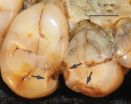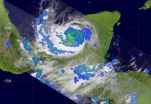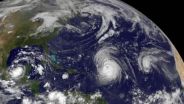(Press-News.org) Were our early mammalian ancestors vegetarians, vegans or omnivores? It's difficult for anthropologists to determine the diet of early mammalians because current fossil analysis provides too little information. But a new method that measures the size of chips in tooth fossils can help determine the kinds of foods these early humans consumed.
Prof. Herzl Chai of Tel Aviv University's School of Mechanical Engineering, in collaboration with scientists from George Washington University and the U.S. National Institute of Standards and Technology (NIST), has developed an equation for determining how the size of a chip found in the enamel of a tooth relates to the bite force needed to produce the chip. With the aid of this information, researchers can better determine the type of food that animals, and early humans, could have consumed during their lifetimes.
Teeth are the only relevant fossils with staying power, Prof. Chai explains. Made of hard, mineralized material, teeth from animals that are thousands of years old remain relatively intact. Teeth that display a greater number of large chips indicate that animals like our early ancestors were consuming harder foods such as nuts, seeds or items with bones. A lesser amount of small chips demonstrates that the animal's diet more likely consisted of softer foods, such as vegetation. Dr. Chai's findings were recently reported in the journal Biology Letters.
Joining anthropology and mechanical engineering
In the recent study, Prof. Chai combined his mechanical engineering background with the expertise of anthropologists at George Washington University and material scientists at NIST to develop a simple equation to predict the maximum bite force used to create a tooth chip. The equation correlates well with a commonly-used equation from jaw mechanics ― a more complex approach for determining the maximum bite force an animal can deliver.
Drawn from "fracture mechanics," concerned with the formation of cracks in brittle materials, Prof. Chai's equation takes into account the dimensions of the chip ― its distance from the edge of the tooth ― and from there solves for the bite force required to have made the chip. The maximum force an animal can apply, notes Prof. Chai, relates to the thickness of the enamel and the size of the tooth itself.
"The bigger the tooth, the bigger area for chips to develop, and therefore, the more force the animal can produce," he says. The team surveyed tooth fossils from many types of mammalians, including six hominins, gorillas and chimpanzees.
We are what we eat
A tooth chip is a permanent signature of consumption, says Prof. Chai. His method demonstrates that the probable food sources of a given animal can be determined from a small number of well-preserved teeth. The fossils used for this particular study were widely available at museums. This is an improvement over previous methods, which relied solely on jaw mechanics and required an almost complete skull to determine eating habits.
This moves researchers one step closer towards grasping the dietary habits of early mammalians. Although the study of tooth chips cannot, thus far, reveal exactly what food produced the chip, it allows researchers to determine a range of foods, providing valuable information about the animal's life that other methods tend to miss.
INFORMATION:
American Friends of Tel Aviv University (www.aftau.org) supports Israel's leading and most comprehensive and most sought-after center of higher learning. Ranked #114 in the world in independent rankings, TAU's innovations and discoveries are cited more often by the global scientific community than all but 20 other universities worldwide.
Internationally recognized for the scope and groundbreaking nature of its research programs, Tel Aviv University consistently produces work with profound implications for the future.
A chip off the early hominin tooth
Tel Aviv University develops method for determining the diet of our early ancestors
2010-09-16
ELSE PRESS RELEASES FROM THIS DATE:
Undergraduate research highlighted in DNA and Cell Biology Journal
2010-09-16
New Rochelle, NY, September 16, 2010—Not only do undergraduate students gain valuable hands-on experience by participating in scientific research projects, but they also make meaningful contributions, examples of which are highlighted in the current special issue of DNA and Cell Biology, a peer-reviewed journal published by Mary Ann Liebert, Inc. The issue is available free online.
This special issue features a collection of papers reporting on successful research projects in which undergraduate students played a significant role, "and undoubtedly learned much in the ...
Bacteria identified that may lead to inflammatory bowel disease in certain individuals
2010-09-16
Certain bacteria that inhabit the intestine provide the environmental trigger that initiates and perpetuates chronic intestinal inflammation in individuals who are genetically susceptible to inflammatory bowel disease (IBD), a study led by Harvard School of Public Health researchers has found.
Inflammatory bowel disease results from a loss of homeostasis, or balance, between the immune system and the microbes that inhabit the intestine. "In this study, we identified two microbes that instigate gut inflammation that leads to inflammatory bowel disease in mice," said ...
UCSB, Texas A&M scientists document fate of deep hydrocarbon plumes in Gulf oil spill
2010-09-16
SANTA BARBARA, Calif., Sept. 16, 2010 — In the aftermath of the Deepwater Horizon disaster in the Gulf of Mexico, a team of scientists led by UC Santa Barbara's David Valentine and Texas A&M University's John Kessler embarked on a research cruise with an urgent mission: determining the fate and impact of hydrocarbon gases escaping from a deep-water oil spill.
The spill provided a rare opportunity for Valentine, a professor in the Department of Earth Science at UCSB, and Kessler, an assistant professor in the Department of Oceanography at Texas A&M, to study the behavior ...
Scripps scientists develop test providing new pathway for identifying obesity, diabetes drugs
2010-09-16
La Jolla, CA, September 15, 2010 – Scientists at The Scripps Research Institute have designed a new molecular test that will allow researchers to look for potential drugs targeting a human metabolic enzyme believed to stimulate the appetite and play a role in diabetes.
The new test, which the scientists call a simple assay, will allow researchers to look through hundreds of thousands of compounds for those that have potential to block the action of an enzyme known as ghrelin O-acyltransferase (GOAT). If drugs can be found that safely suppress the action of GOAT, they ...
Fat stem cells safe for breast reconstruction when cancer is dormant, says Pitt team
2010-09-16
PITTSBURGH, Sept. 15 – Fat-derived stem cells can be safely used to aid reconstruction of breast tissue after mastectomy as long as there is no evidence of active cancer, according to researchers at the University of Pittsburgh School of Medicine. Their findings are available in Tissue Engineering Part A.
Plastic surgeons have long moved fat from one part of the body into the breasts for reconstruction, but with some complications and a varying success rate, explained senior author Vera S. Donnenberg, Ph.D., assistant professor of surgery, Pitt School of Medicine. More ...
Significant weight-loss from surgery decreases risk for cardiovascular disease in women
2010-09-16
Significant weight loss not only improves daily life of morbidly obese woman but also decreases the risk for cardiovascular disease (CVD). However, many people can not lose weight or can not maintain weight loss without help. Bariatric surgery is emerging as a valuable procedure to help morbidly obese individuals lose weight, as studies have shown; it can improve many health profiles and lower mortality. Now, researchers have found another positive impact of significant weight loss after bariatric surgery: it can significantly improve the lipoprotein profiles of women within ...
NASA eyes Karl, now a hurricane in the Gulf of Mexico
2010-09-16
NASA's Aqua and TRMM satellites have been watching Karl's clouds and rainfall as he moved across Mexico's Yucatan Peninsula and into the Gulf of Mexico today, powering up into a hurricane.
Infrared imagery of Karl's cloud temperatures from NASA's Atmospheric Infrared Sounder (AIRS) instrument this morning, Sept. 16 at 0753 UTC (3:53 a.m. EDT) showed strong convective activity in his center as indicated by high thunderstorms that were as cold as -63 Fahrenheit. That strong convection was an indication that the warm waters of the Gulf of Mexico were strengthening the storm. ...
Developing countries may not benefit from adopting international treaties
2010-09-16
CORVALLIS, Ore. – A new study by an Oregon State University business professor has found that developing countries that adopt major international economic treaties do not necessarily gain more foreign direct investment.
In fact, in some cases adopting these treaties can hurt, not help a developing country, contrary to what agencies such as the World Trade Organization (WTO) espouse. The study, published in the current online version of the Journal of World Business, has major implications for Latin American and Caribbean intellectual policy reform
Ted Khoury, an assistant ...
GOES-13 sees a weaker Hurricane Julia in the 'tropical trio'
2010-09-16
GOES-13 satellite imagery this morning showed the "tropical trio": Tropical Storm Karl over the Gulf of Mexico, Hurricane Igor in the central Atlantic, and a waning Hurricane Julia in the eastern Atlantic Ocean. Hurricane Julia has now lost her Category 4 Hurricane status, and is currently a Category 2 hurricane in the eastern Atlantic and weakening. Wind shear, cooler sea surface temperatures and warmer cloud top temperatures all spell a weaker Julia.
The Geostationary Operational Environmental Satellite known as GOES-13 that monitors weather over the U.S. East Coast ...
Study: How Palestinian and Israeli children are psychologically scarred by exposure to war
2010-09-16
ANN ARBOR, Mich.---As another round of talks continues between Israelis and Palestinians, a new University of Michigan study documents the impact the violence has been inflicting on the region's children.
Palestinian and Israeli children not only suffer the direct physical consequences of violence, they are also being psychologically scarred by the high levels of violence they witness, according to the study, presented earlier this summer at the International Society for Research on Aggression.
Nearly 50 percent of Palestinian children between the ages of 11 and 14 ...
LAST 30 PRESS RELEASES:
First Editorial of 2026: Resisting AI slop
Joint ground- and space-based observations reveal Saturn-mass rogue planet
Inheritable genetic variant offers protection against blood cancer risk and progression
Pigs settled Pacific islands alongside early human voyagers
A Coral reef’s daily pulse reshapes microbes in surrounding waters
EAST Tokamak experiments exceed plasma density limit, offering new approach to fusion ignition
Groundbreaking discovery reveals Africa’s oldest cremation pyre and complex ritual practices
First breathing ‘lung-on-chip’ developed using genetically identical cells
How people moved pigs across the Pacific
Interaction of climate change and human activity and its impact on plant diversity in Qinghai-Tibet plateau
From addressing uncertainty to national strategy: an interpretation of Professor Lim Siong Guan’s views
Clinical trials on AI language model use in digestive healthcare
Scientists improve robotic visual–inertial trajectory localization accuracy using cross-modal interaction and selection techniques
Correlation between cancer cachexia and immune-related adverse events in HCC
Human adipose tissue: a new source for functional organoids
Metro lines double as freight highways during off-peak hours, Beijing study shows
Biomedical functions and applications of nanomaterials in tumor diagnosis and treatment: perspectives from ophthalmic oncology
3D imaging unveils how passivation improves perovskite solar cell performance
Enriching framework Al sites in 8-membered rings of Cu-SSZ-39 zeolite to enhance low-temperature ammonia selective catalytic reduction performance
AI-powered RNA drug development: a new frontier in therapeutics
Decoupling the HOR enhancement on PtRu: Dynamically matching interfacial water to reaction coordinates
Sulfur isn’t poisonous when it synergistically acts with phosphine in olefins hydroformylation
URI researchers uncover molecular mechanisms behind speciation in corals
Chitin based carbon aerogel offers a cleaner way to store thermal energy
Tracing hidden sources of nitrate pollution in rapidly changing rural urban landscapes
Viruses on plastic pollution may quietly accelerate the spread of antibiotic resistance
Three UH Rainbow Babies & Children’s faculty elected to prestigious American Pediatric Society
Tunnel resilience models unveiled to aid post-earthquake recovery
Satellite communication systems: the future of 5G/6G connectivity
Space computing power networks: a new frontier for satellite technologies
[Press-News.org] A chip off the early hominin toothTel Aviv University develops method for determining the diet of our early ancestors


